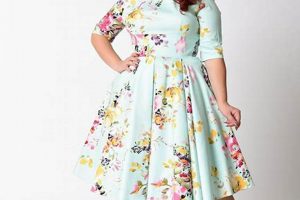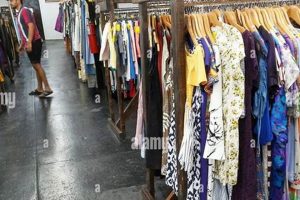Apparel originating from the 1940s, often referred to as garments of a bygone era, embodies the stylistic trends prevalent during that decade. Examples include A-line skirts, wide-leg trousers, dresses with nipped-in waists, and utility-driven designs reflecting wartime resourcefulness. Fabric choice and construction methods are key indicators of authenticity.
These items offer a tangible connection to the past, providing insight into the social, economic, and political climate of the time. The garments represent a departure from the excess of previous eras, favoring practicality and elegance within constraints. Owning or studying such pieces contributes to an understanding of historical fashion evolution and its impact on subsequent trends.
The following sections will delve into specific aspects of this sartorial period, including fabric considerations, silhouette variations, prevalent accessories, and tips for identifying genuine articles. Consideration will also be given to preservation techniques for these delicate and historically significant textiles.
Guidance on Authentic Garments from the 1940s
Acquiring authentic apparel from this decade necessitates meticulous attention to detail. Examination of construction, materials, and design elements proves crucial.
Tip 1: Assess Fabric Composition. Rayon, crepe, and wool gabardine were frequently used. Identify these materials and differentiate them from later synthetic imitations.
Tip 2: Scrutinize Fastenings. Zippers, if present, should be metal. Buttons often comprised bakelite or other early plastics. Inconsistencies suggest alterations or reproduction.
Tip 3: Examine Seams and Hems. Garments of this era typically exhibit hand-finished details or meticulously executed machine stitching. Avoid items with serged edges or overly modern seam construction.
Tip 4: Investigate Labels and Markings. Research period-specific labels to verify authenticity. Absence of a label does not automatically indicate a fake, but its presence, if accurate, can be a strong indicator.
Tip 5: Evaluate the Silhouette. The characteristic silhouette featured defined shoulders, a fitted waist, and a skirt that fell to the knee or just below. Deviations from this profile warrant further scrutiny.
Tip 6: Check Print and Color. Common prints included florals, geometric patterns, and polka dots. Colors tended to be muted, reflecting wartime austerity, though some vibrant shades existed. Research typical color palettes for accurate assessment.
Tip 7: Consider the Garment’s Condition. Expect minor wear and tear commensurate with age. However, excessive damage or obvious repairs can detract from value and authenticity.
Diligent application of these guidelines enhances the likelihood of acquiring genuine examples of this period, allowing for a more informed and satisfying collecting experience.
The concluding section will address ethical considerations related to the acquisition and preservation of such historically significant textiles.
1. Silhouette
The defining characteristic of attire from the 1940s lies in its distinctive silhouette. The decade witnessed a significant shift in fashion, largely influenced by wartime austerity and the evolving roles of women. The silhouette of garments from this era typically featured a defined shoulder line, often achieved through padding or strategic seaming, a nipped-in waist emphasizing an hourglass figure, and a skirt that extended to the knee or just below. This combination created a structured yet feminine aesthetic, distinctly different from the looser, more flowing styles of the preceding decades. Consider, for example, the iconic “Victory Suit,” a practical and stylish ensemble that embodied this silhouette. Its tailored jacket, with strong shoulders and a cinched waist, paired with a knee-length skirt, exemplified the prevailing fashion ideal.
The emphasis on a defined waist and structured shoulders can be attributed, in part, to the need to create a sense of empowerment and confidence during a time of uncertainty. Clothing became a means of projecting strength and resilience. Furthermore, fabric rationing necessitated innovative tailoring techniques to maximize the use of available materials, leading to the development of designs that emphasized form and efficiency. The influence of Hollywood glamour also played a significant role, with actresses such as Katherine Hepburn and Rita Hayworth popularizing the defined silhouette through their on-screen and off-screen attire. The A-line skirt, often seen in dresses and suits, provided a flattering and practical silhouette for women who were increasingly entering the workforce.
Understanding the importance of silhouette is crucial for accurately identifying and appreciating garments from the 1940s. It serves as a primary indicator of authenticity and provides valuable insight into the historical and cultural context in which these clothes were created and worn. While minor variations existed, the core elements of the defined shoulder, cinched waist, and knee-length skirt remained consistent, shaping the overall aesthetic of this influential decade. Recognition of this defining form allows for a deeper appreciation of the ingenuity and resourcefulness that characterized the fashion of the time.
2. Fabric
The selection and utilization of textiles during the 1940s significantly influenced the design, durability, and overall aesthetic of garments from that era. Material constraints imposed by wartime rationing prompted innovative approaches to fabric usage and sourcing. Examining fabric types provides critical insights into the construction and authenticity of apparel from this decade.
- Rayon’s Prevalence
Rayon, a semi-synthetic fiber, gained widespread popularity due to its affordability and versatility as a substitute for silk. It was used extensively in dresses, blouses, and linings. Examples include rayon crepe dresses with intricate draping and rayon satin used for evening wear. The prevalence of rayon reflects the need for economical yet aesthetically pleasing fabric options during wartime.
- Wool’s Wartime Role
Wool, particularly wool gabardine, was crucial for military uniforms and civilian outerwear. Its durability and warmth made it essential in colder climates. Suits, coats, and skirts were commonly constructed from wool gabardine. Government restrictions often prioritized wool for military use, impacting its availability and driving innovation in blending wool with other fibers.
- Cotton’s Utility
Cotton served as a staple fabric for everyday wear, including work clothes, blouses, and children’s garments. Cotton prints, often featuring floral or geometric designs, were popular for dresses and skirts. The practicality and affordability of cotton made it a widely accessible material for diverse applications.
- Nylon’s Novelty
Nylon, a newly developed synthetic fiber, emerged during this period but was primarily allocated to military applications, such as parachutes and ropes. Limited quantities were available for civilian use, mainly in stockings. The introduction of nylon represented a significant advancement in textile technology, foreshadowing its widespread adoption in later decades.
These fabric choices underscore the resourcefulness and adaptability of the fashion industry in response to wartime conditions. The prevalence of rayon, the strategic use of wool, the consistent presence of cotton, and the nascent introduction of nylon collectively define the textile landscape of 1940s attire. Examination of fabric composition is a key factor in assessing the authenticity and historical context of vintage garments from this period. These materials not only shaped the look and feel of the attire but also reflected the social and economic realities of the era.
3. Details
The meticulous details incorporated into apparel from the 1940s serve as defining characteristics, reflecting both the aesthetic preferences and the resource constraints of the era. Examining these elements provides crucial insight into the authenticity and historical context of the garments. The influence of wartime austerity dictated a focus on functionality and durability, leading to innovative solutions in garment construction and embellishment. For example, the use of self-fabric belts or covered buttons not only conserved materials but also added a touch of elegance to otherwise utilitarian designs.
Further examination reveals the importance of specific closures, such as metal zippers (often with distinctive markings), and the prevalence of hand-stitched finishes, indicative of pre-mass production techniques. The design of collars and cuffs, often featuring subtle embellishments or contrasting fabrics, contributed to the overall sophistication of attire. Attention to detail also extended to practical considerations, such as reinforced seams and strategically placed pockets, designed to enhance the garment’s functionality in a period when resourcefulness was paramount. The careful consideration of these details is a testament to the craftsmanship and ingenuity of the era. This is evident, for instance, in the intricate darting and seaming used to create a flattering silhouette in dresses and suits, despite fabric limitations.
Understanding the significance of these details is essential for collectors, researchers, and anyone seeking to appreciate the nuances of sartorial history. It allows for a more informed assessment of a garment’s authenticity and provides a deeper connection to the historical and cultural context in which it was created. The challenge lies in discerning genuine details from later alterations or embellishments. However, careful observation and research can yield valuable insights into the world of this era and its enduring influence on fashion.
4. Function
The role of function in shaping apparel of the 1940s is undeniably significant, primarily due to the pervasive influence of World War II. The global conflict created an environment where practicality and resourcefulness were paramount, dictating design choices across all levels of dress. This necessity affected material selection, construction techniques, and the overall aesthetic of garments, resulting in a style that prioritized utility without sacrificing elegance. The drive for function thus became an intrinsic component of clothing produced in this decade.
Examples of this functional focus are readily apparent. The “Victory Suit,” designed for women entering the workforce, embodies this principle. Its durable fabric, often wool or a wool blend, and tailored construction provided a professional and practical ensemble suitable for various employment roles. Likewise, dresses frequently featured simple, A-line designs that allowed for ease of movement and versatility, crucial for women juggling work and household responsibilities. Military-inspired details, such as epaulettes and utilitarian pockets, also found their way into civilian attire, reflecting a culture that valued efficiency and purposefulness. Furthermore, fabric conservation measures led to innovative pattern-making techniques, minimizing waste and maximizing the use of available materials.
Understanding the functional drivers behind 1940s attire is crucial for accurately assessing and appreciating garments from this period. It allows one to move beyond mere aesthetic appreciation and delve into the socio-economic factors that influenced their creation. Furthermore, this understanding informs preservation efforts, ensuring that the practical aspects of these garments, such as their durability and functionality, are maintained. Though challenges exist in fully reconstructing the original intent and usage of each garment, recognizing the overarching emphasis on function provides a vital lens through which to interpret and understand the sartorial legacy of the 1940s.
5. Durability
The durability of attire from the 1940s stands as a testament to the quality of materials and construction techniques employed during that era. Wartime restrictions and resource scarcity necessitated the creation of garments designed for longevity. This emphasis on endurance, driven by economic and practical imperatives, is a key characteristic that distinguishes genuine articles of the period. Fabric choices such as wool gabardine, known for its resilience, and sturdy cotton twills were favored for everyday wear. Furthermore, meticulous stitching, reinforced seams, and durable closures contributed to the extended lifespan of these garments. The longevity of 1940s apparel is not merely a matter of chance; it reflects a deliberate design philosophy centered on creating items that would withstand the rigors of daily life.
The practical significance of this durability is evident in the fact that many garments from this era have survived to the present day. These surviving pieces provide tangible evidence of the quality and craftsmanship of the time. For instance, a wool suit from the 1940s, properly cared for, can still be worn today, offering a glimpse into the style and functionality of a bygone era. Similarly, durable cotton dresses and workwear serve as historical artifacts, illustrating the clothing needs and preferences of working-class individuals. This enduring quality allows for the continued study and appreciation of 1940s fashion, offering valuable insights into social, economic, and technological trends of the time. The enduring nature of these garments also provides a sustainable alternative to modern fast fashion, promoting a more environmentally conscious approach to clothing consumption.
While challenges exist in maintaining and preserving these vintage items, the intrinsic durability of garments from the 1940s significantly enhances their longevity and historical value. Understanding the materials, construction methods, and design philosophies that contributed to their enduring quality is essential for collectors, researchers, and anyone seeking to appreciate the lasting impact of this era on fashion. The durability of this attire serves as a reminder of a time when clothing was valued for its functionality and longevity, rather than its disposability, a perspective that holds considerable relevance in contemporary society.
6. Rarity
The concept of rarity significantly influences the value and desirability of authentic apparel originating from the 1940s. Factors contributing to an item’s scarcity directly impact its collectibility and historical significance. Understanding these elements is essential for discerning the true worth of such garments.
- Limited Production Runs
Wartime restrictions on materials and manufacturing capabilities inherently limited the production volume of specific garments. Certain designs, fabrics, or embellishments were produced in smaller quantities due to resource constraints or specific wartime needs. For example, dresses utilizing silk or nylon, materials heavily prioritized for military applications, would be significantly rarer than those crafted from more readily available rayon or cotton. This limited production translates directly into increased value for surviving examples.
- Designer or Couture Pieces
Attire created by renowned designers or couture houses during the 1940s, though not necessarily produced in vast quantities initially, represent a smaller fraction of surviving examples. The higher cost and exclusive nature of these garments ensured limited distribution, even at the time of production. Identifying labels or design features indicative of such origins significantly enhances the item’s rarity and desirability. Pieces from designers like Adrian or Schiaparelli from this era are highly sought after.
- Preservation Challenges
The passage of time and inherent fragility of textiles contribute to the rarity of well-preserved garments. Improper storage, wear and tear, and damage from pests or environmental factors reduce the number of intact examples available. Garments that have retained their original form, color, and construction details command a premium due to their relative scarcity. Preservation also hinges on proper storage; garments stored in less than optimal conditions are at risk of decay, making well-preserved items increasingly rare.
- Specialized or Niche Items
Certain types of garments, such as maternity wear, specialized work attire, or items produced for specific cultural or social events, were often manufactured in smaller numbers and are therefore less commonly encountered today. These niche pieces offer valuable insights into specific aspects of 1940s life and are highly sought after by collectors interested in these focused areas. For example, uniforms from specialized war-effort occupations can be extremely rare.
The interplay of limited production, designer origins, preservation challenges, and specialized uses directly impacts the scarcity and, consequently, the value and historical significance of vintage attire from the 1940s. The identification and appreciation of these factors are crucial for collectors and researchers seeking to understand the full scope of sartorial history from that era.
7. Origin
The origin of apparel from the 1940s provides crucial context for understanding its design, construction, and cultural significance. Tracing a garment’s provenance reveals insights into manufacturing practices, economic conditions, and the societal influences shaping its creation. Knowledge of origin assists in authenticating pieces and appreciating their historical value.
- Manufacturing Hubs and Regional Styles
Garment production during this era concentrated in specific geographic regions, each characterized by distinct manufacturing capabilities and stylistic preferences. For example, New York City served as a major center for garment design and mass production, influencing styles widely disseminated across the United States. European fashion houses, despite wartime disruptions, continued to exert influence, with Paris maintaining its reputation for haute couture. Understanding these regional variations aids in identifying a garment’s likely origin and assessing its adherence to prevailing style norms. The prevalence of specific textile mills in certain areas further informs the origin story, providing insight into material sourcing.
- Domestic vs. Imported Goods
The origin of materials used in clothing construction significantly impacted design and availability. Wartime restrictions limited access to imported textiles, leading to a greater reliance on domestically produced fabrics. Identifying whether a garment utilized imported silk or locally sourced rayon offers clues about its intended market and potential cost. Examination of labels and markings can reveal whether the garment was manufactured domestically or imported, providing further evidence of its origin. The presence of import duties or customs stamps can confirm international origins.
- Designer and Brand Influence
Tracing a garment back to a specific designer or brand provides invaluable information about its quality, style, and intended market. Renowned designers such as Adrian and Claire McCardell established distinct aesthetic signatures, influencing the design of garments bearing their labels. Identifying a designer’s influence helps contextualize the garment within broader fashion trends and assess its historical significance. The presence of a designer label adds to the garment’s collectability and value. However, the absence of a label does not necessarily negate a designer’s influence, as many garments were produced without formal branding.
- Wartime Production and Military Influence
The origin of many garments during the 1940s is inextricably linked to wartime production and military contracts. Factories repurposed for military manufacturing often produced clothing for civilian use, reflecting a blend of utilitarian design and available resources. Identifying garments with military-inspired details, such as epaulettes or patch pockets, provides clues about their potential wartime origin. Analysis of manufacturing contracts and government records can further illuminate the connection between civilian attire and military production. These items represent a unique intersection of fashion and wartime necessity.
By carefully considering these factors manufacturing hubs, material sourcing, designer influence, and wartime production a more complete understanding of a garment’s origin emerges. This knowledge enhances the appreciation of vintage 40s clothes, offering insights into the economic, social, and technological forces shaping their creation. Further research into specific manufacturers or regional styles can provide even greater detail, enriching the historical narrative surrounding these tangible artifacts of the past.
Frequently Asked Questions
The following section addresses common inquiries and dispels misconceptions regarding apparel originating from the 1940s, providing a clearer understanding of their historical and stylistic significance.
Question 1: How does one distinguish authentic garments from the 1940s from reproductions?
Authenticity assessment involves scrutinizing construction techniques, fabric composition, and design details. Period-accurate garments typically feature metal zippers, rayon or wool crepe fabrics, and hand-finished seams. Reproductions often exhibit synthetic materials, modern stitching methods, and inaccurate design elements.
Question 2: What were the common fabrics used in apparel from this period?
Rayon, wool gabardine, cotton, and, to a lesser extent, nylon were prevalent. Silk was less common due to wartime restrictions. Identifying these materials is a key step in determining the authenticity and intended use of a garment.
Question 3: How did World War II influence clothing design?
Wartime austerity measures resulted in simplified designs, reduced fabric usage, and the incorporation of utilitarian details. Military-inspired styles, such as the “Victory Suit,” became popular. Resourcefulness and practicality were paramount design considerations.
Question 4: What styles were prevalent during this era?
Characteristic silhouettes included defined shoulders, a cinched waist, and skirts that fell to the knee or just below. Dresses, suits, and separates often featured A-line shapes and practical embellishments. Emphasis was placed on creating a feminine yet functional aesthetic.
Question 5: How should garments from this period be properly cared for and preserved?
Proper care involves gentle hand washing or professional dry cleaning, careful storage in acid-free materials, and protection from sunlight and pests. Avoid harsh chemicals and excessive handling to prolong the lifespan of delicate textiles.
Question 6: What factors influence the value of authentic items from this decade?
Value is determined by factors such as rarity, condition, designer provenance, and historical significance. Garments in excellent condition, crafted by renowned designers, or representing unique aspects of wartime fashion command higher prices.
These answers provide a foundation for understanding the intricacies of garments from the 1940s. Further research and careful examination are recommended for those seeking a deeper appreciation of this era’s sartorial legacy.
The subsequent section will delve into ethical considerations surrounding the acquisition and preservation of historical textiles.
Conclusion
The preceding exploration has illuminated the multifaceted nature of garments originating from the 1940s. Key aspects such as silhouette, fabric composition, construction details, functional considerations, durability, rarity, and provenance have been examined, providing a comprehensive framework for understanding and appreciating this era’s sartorial contributions. The impact of wartime austerity, resource limitations, and evolving social roles on fashion design has been underscored.
Further research and diligent preservation efforts are paramount to ensuring that the legacy of this distinctive period endures. The continued study of vintage 40s clothes offers invaluable insights into the past, informing our understanding of design, history, and cultural evolution. Therefore, meticulous acquisition and thoughtful stewardship of these artifacts is essential for future generations.







